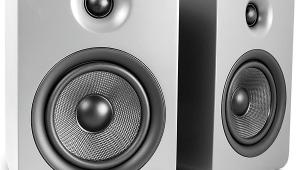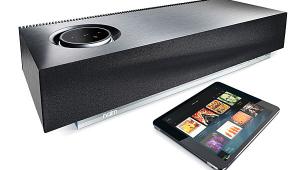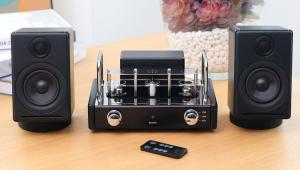Test Report: Focal Little Bird 2.1 Speaker System Page 2
Performance
Focal’s Bird Series raises a host of interesting questions, beginning with: Why can’t all small speakers sound this good? Yes, the Little Bird system was a tad light in the “body” octave (between, say, 100 and 200 Hz), which gave its bright, airy presentation a very slightly “forward” tilt on voices and strings. But oh boy, what a presentation! The Focal setup’s depth, detail, and stereo soundstage breadth and precision are breathtaking, and you’ll notice it from the first upbeat of the first high-quality recording you play.
Mark Knopfler’s solo albums exemplify state-of-the-art studio-pop recording techniques, such that songs like “Remembrance Day” (from 2009’s Get Lucky) sound great even when heard through an average-to-good audio system. With a high-end setup, though, you quickly begin calling out nuances — like the spatial depth to the “tock” of a snare-rim hit, or the rich tonal complexity of Knopfler’s trademark guitar sound. And, of course, that inimitable beef-stew baritone voice. You just know that somebody spent hours or even days choosing and positioning the “overhead” drums mike and the main vocal mike, as well as moving an equally carefully selected guitar-cabinet mike a half-inch at a time to find the perfect sweet spot on the cone. The result is an almost surround-like sense of spatial richness. And my point is this: The Little Bird 2.1 thus qualifies as an honestly audiophile “B chain,” fully capable of the tonal and spatial shadings that mark the often blurry distinction between hi-fi ’s audiophile and mid-fi divisions.
Larger-scale works like a full symphony orchestra — or even full-bore rock — didn’t fare quite as well, as the Little Bird’s volume limit, though more than ample for a modest room, cramped big-impact dynamics a bit at higher volumes. So it was the more chamber-size works that let Focal’s suite shine its brightest. John Adams’s early Shaker Loops is among the American composer’s most accessible and attractive works (imagine the illicit love child of Appalachian Spring-era Aaron Copland and U2’s The Edge), and the Little Bird system presented its ever-shifting-yet-static soundscapes with electrifying transparency. The alternately dense, almost overwhelmingly rich and detailed massed-string textures and the ghostly episodes of harmonics and sotto voce tremolos carried enormous tonal conviction and dynamic subtlety, yielding the kind of sucked-in immersion that high-end audio is all about.
More prosaically, the Little Bird 2.1 evidenced, as already mentioned, a slight dearth in the upper-bass regions that made most pop music sound a bit less weighty, and a very slight emphasis in the tip-top-mids. The combination doubtless contributed much to the system’s extraordinary precision and spatial definition, however, and I did not find the resultant colorations the least bit worrisome. A reduction in the boom-and-thud octave is almost always welcome (even when it’s a reduction from literal accuracy), and the minute touch of treble bite attending the system’s slight upper-presence boost is a fair price for so sparkling a sonic signature.
- Log in or register to post comments

























































